What is the Law of Independent Assortment when it comes to genetics
ane.6: The law of contained assortment
- Page ID
- 73823
Introduction
The law of segregation lets us predict how a single feature associated with a unmarried cistron is inherited. In some cases, though, nosotros might want to predict the inheritance of ii characteristics associated with two different genes. How can we do this?
- [Refresher on the law of segregation]
-
The police force of segregation states that each gamete (sperm or egg cell) made past an organism will go just ane of the two gene copies present in a parent organism, and that the gene copies are randomly allocated to the gametes. For instance, if an organism has a genotype of Aa, half of its gametes will contain an A allele, and the other one-half volition contain an a allele.
Y'all tin utilise the link at the start of the paragraph to acquire more about the law of segregation.
To make an authentic prediction, we need to know whether the two genes are inherited independently or not. That is, we need to know whether they "ignore" i another when they're sorted into gametes, or whether they "stick together" and get inherited as a unit.
When Gregor Mendel asked this question, he found that dissimilar genes were inherited independently of i some other, following what's called the law of contained array. In this article, we'll take a closer expect at the police force of independent assortment and how it is used to make predictions. We'll also see when and why the police of independent array does (or doesn't!) hold truthful.
Note: If y'all are non yet familiar with how individual genes are inherited, you may want to cheque out the article on the police force of segregation or the introduction to heredity video before y'all dive into this commodity.
What is the law of independent assortment?
Mendel's police force of independent array states that the alleles of two (or more) different genes get sorted into gametes independently of one some other. In other words, the allele a gamete receives for 1 gene does non influence the allele received for another gene.
Example: Pea color and pea shape genes
Let's look at a concrete instance of the law of independent assortment. Imagine that we cross two pure-breeding pea plants: ane with xanthous, round seeds (YYRR) and one with light-green, wrinkled seeds (yyrr). Considering each parent is homozygous, the police of segregation tells united states that the gametes made by the wrinkled, dark-green plant all are ry, and the gametes made past the circular, yellowish plant are all RY. That gives us Fone offspring that are all RrYy.
The allele specifying yellowish seed color is ascendant to the allele specifying green seed colour, and the allele specifying circular shape is dominant to the allele specifying wrinkled shape, equally shown past the capital letter and lower-case letters. This means that the F1 plants are all yellow and circular. Because they are heterozygous for two genes, the F1 plants are called dihybrids (di- = two, -hybrid = heterozygous).
A cross betwixt two dihybrids (or, equivalently, self-fertilization of a dihybrid) is known as a dihybrid cross. When Mendel did this cross and looked at the offspring, he found that there were four different categories of pea seeds: yellowish and round, yellow and wrinkled, green and round, and green and wrinkled. These phenotypic categories (categories defined by appreciable traits) appeared in a ratio of approximately 9:3:3:1.
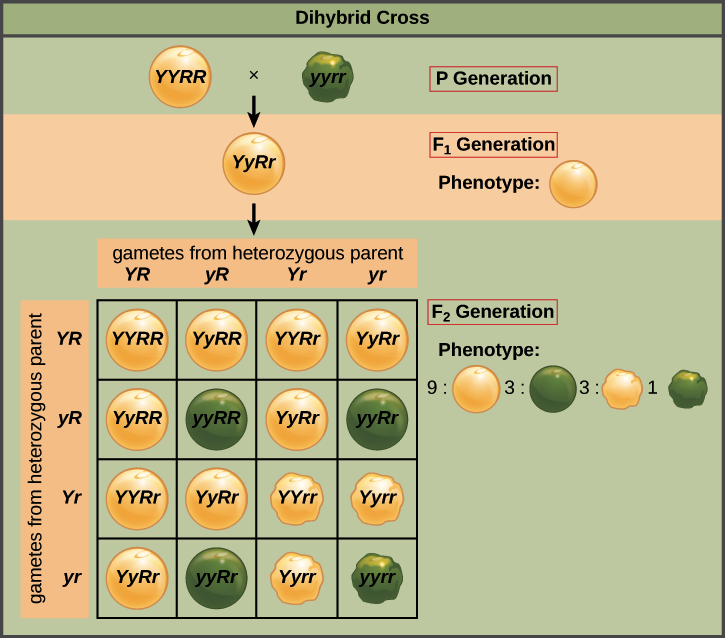
This ratio was the key clue that led Mendel to the police force of independent assortment. That'southward considering a nine:3:3:i ratio is exactly what we'd expect to meet if the F1 institute made iv types of gametes (sperm and eggs) with equal frequency: Twelvemonth, Yr, yR, and yr. In other words, this is the upshot we'd predict if each gamete randomly got a Y or y allele, and, in a separate process, also randomly got an R or r allele (making four every bit probable combinations).
We can ostend the link between the four types of gametes and the 9:3:3:1 ratio using the Punnett square above. To make the square, nosotros starting time put the iv as probable gamete types along each axis. Then, nosotros join gametes on the axes in the boxes of the chart, representing fertilization events. The sixteen equal-probability fertilization events that tin occur among the gametes are shown in the sixteen boxes. The offspring genotypes in the boxes correspond to a 9:3:three:ane ratio of phenotypes, just as Mendel observed.
- [More about two-gene Punnett squares]
-
We can draw a Punnett square for a two-gene scenario by following the same basic rules every bit for a monohybrid cantankerous, placing the gametes along the axes and combining them in the squares to stand for fertilization events. Nonetheless, since there are now more gamete types, in that location must also be more squares in the table: 4 possible types of maternal gametes x 4 possible types of paternal gametes = sixteen squares total.
As with a single-gene Punnett square, we place all the possible types of gametes along the axes, then combine them in the squares where the columns and rows intersect to represent fertilization events (the formation of zygotes, or offspring).
To larn how you can employ the rules of probability to predict the outcome of a dihybrid cantankerous, see the probabilities in genetics article.
Contained assortment vs. linkage
The department above gives us Mendel's law of contained assortment in a nutshell, and lets us meet how the law of independent assortment leads to a 9:three:3:1 ratio. Only what was the alternative possibility? That is, what would happen if two genes didn't follow independent assortment?
In the extreme case, the genes for seed color and seed shape might have always been inherited as a pair. That is, the xanthous and round alleles might e'er have stayed together, and then might the greenish and wrinkled alleles.
To encounter how this could work, imagine that the color and shape genes are physically stuck together and cannot be separated, equally represented by the boxes around the alleles in the diagram below. For example, this could happen if the ii genes were located very, very close together on a chromosome (an idea we'll explore further at the terminate of the article).
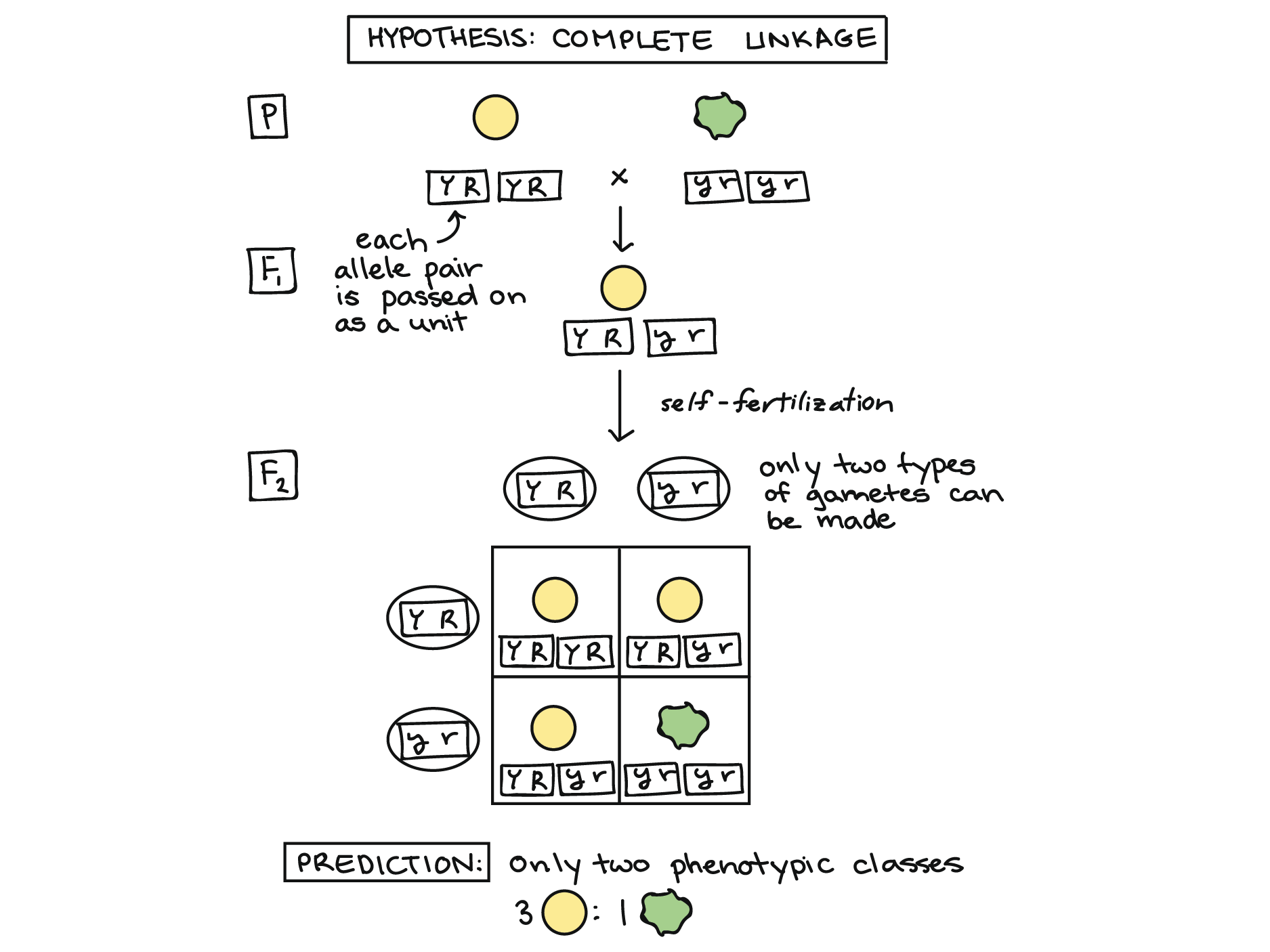
Rather than giving a color allele and, separately, giving a shape allele to each gamete, the Fone dihybrid plant would merely give one "combo unit" to each gamete: a YR allele pair or a yr allele pair.
We can use a Punnett square to predict the results of self-fertilization in this case, as shown above. If the seed colour and seed shape genes were in fact always inherited as a unit, or completely linked, a dihybrid cross should produce just ii types of offspring, yellow/round and greenish/wrinkled, in a iii:1 ratio. Mendel's actual results were quite dissimilar from this (the 9:3:3:1 ratio nosotros saw earlier), telling him that the genes assorted independently.
The reason for independent array
To meet why independent array happens, we demand to fast-forward half a century and find that genes are physically located on chromosomes. To be exact, the two copies of a factor carried past an organism (such as a Y and a y allele) are located at the same spot on the two chromosomes of a homologous pair. Homologous chromosomes are like but non-identical, and an organism gets one member of the pair from each of its two parents.
The concrete basis for the police force of contained assortment lies in meiosis I of gamete germination, when homologous pairs line up in random orientations at the heart of the cell as they prepare to dissever. Nosotros can become gametes with different combos of "mom" and "dad" homologues (and thus, the alleles on those homologues) because the orientation of each pair is random.
To see what this ways, compare chromosome arrangement one (height) and chromosome arrangement 2 (lesser) at the stage of metaphase I in the diagram below. In one case, the red "mom" chromosomes go together, while in the other, they split up up and mix with the blue "dad" chromosomes. If meiosis happens many times, every bit it does in a pea plant, we will get both arrangements—and thus RY, Ry, rY, and ry classes of gametes—with equal frequency.
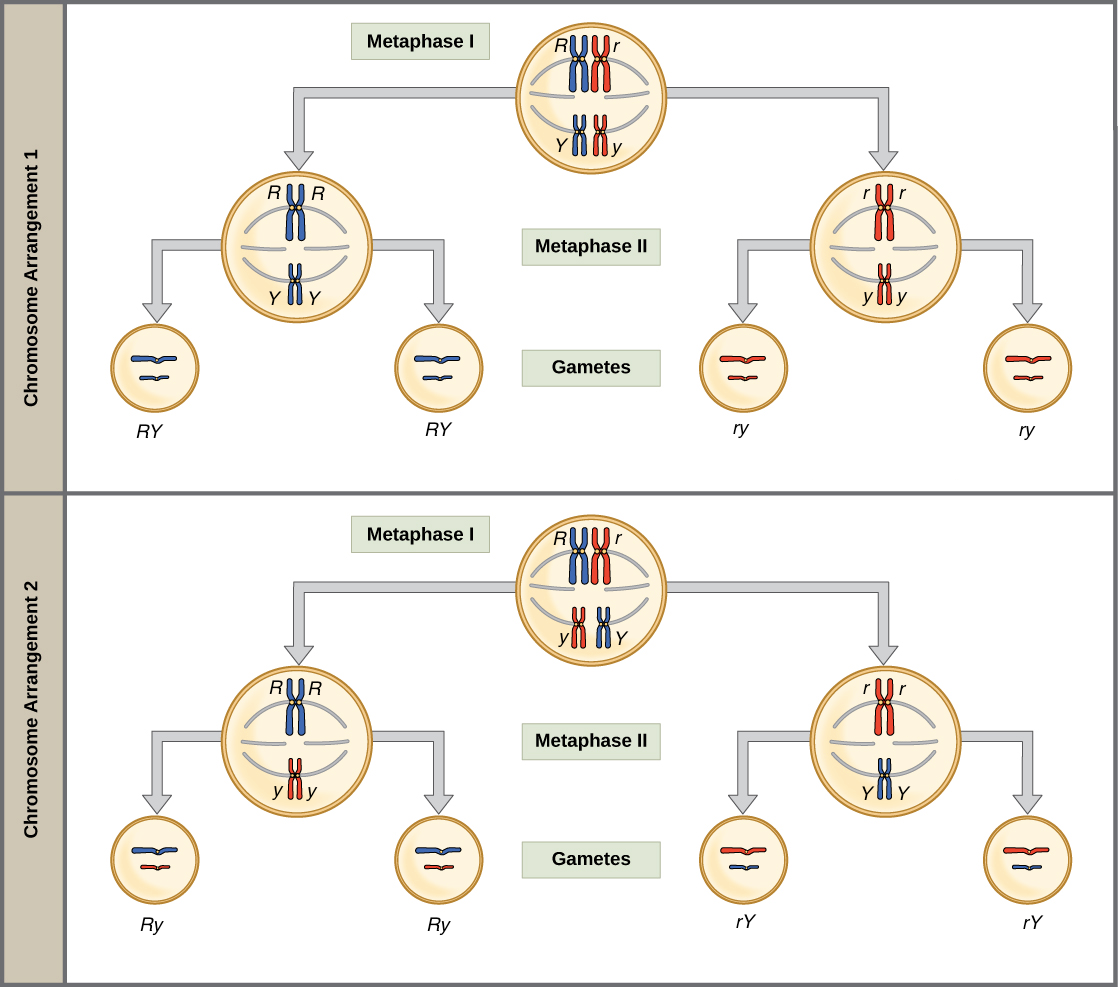
Genes that are on dissimilar chromosomes (like the Y and R genes) assort independently. The seed colour and seed shape genes are on chromosomes one and 7 of the pea genome, respectively, in real lifeone. Genes that are far apart on the same chromosome also assort independently thank you to the crossing over, or substitution of homologous chromosome bits, that occurs early in meiosis I.
- [Meet a moving picture]
-
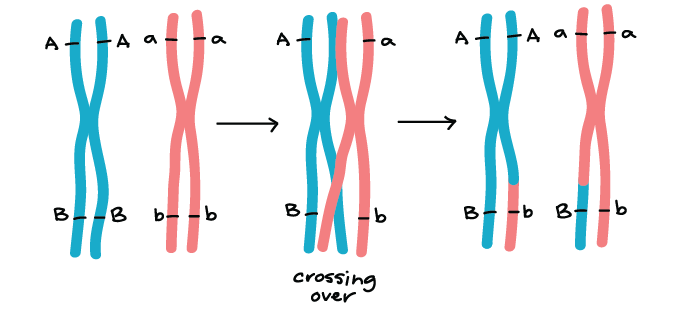
There are, however, factor pairs that do non assort independently. When genes are shut together on a chromosome, the alleles on the same chromosome tend to be inherited equally a unit more oftentimes than not. Such genes exercise non display independent assortment and are said to be linked. We'll take a closer await at genetic linkage in other articles and videos.
- [See a picture]
-
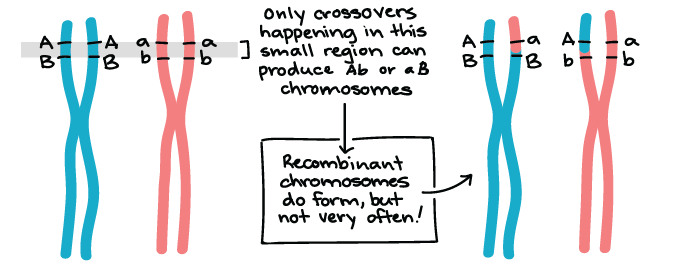
Check your understanding
Query \(\PageIndex{1}\)
- [Hint]
-
Since all of the F1 dogs are blackness and straight-furred, we know that blackness fur color and directly fur texture are ascendant over xanthous fur color and curly fur texture. If we call the color gene B/b and the texture gene C/c, and use capital letters for the ascendant grade of each factor and lowercase letters for the recessive course, nosotros tin can assign the two parental dogs genotypes of BBcc (black and curly) and bbCC (yellow and straight-furred). When the parental dogs are crossed, they produce black, straight-furred F1 dogs that are dihybrids: BbCc.
A cantankerous between two F1 dihybrid dogs results in the Punnett square shown beneath. The F1 dogs can brand four dissimilar types of gametes, which are represented forth the two axes of the Punnett square. The squares of the table represent fertilization events in which the gametes on the axes combine. Since all of the gamete types are every bit likely to be produced (considering the genes assort independently, i.e., exercise not influence each other's inheritance), all the squares in the table represent equal-probability events, ones that occur 1/16 of the time.
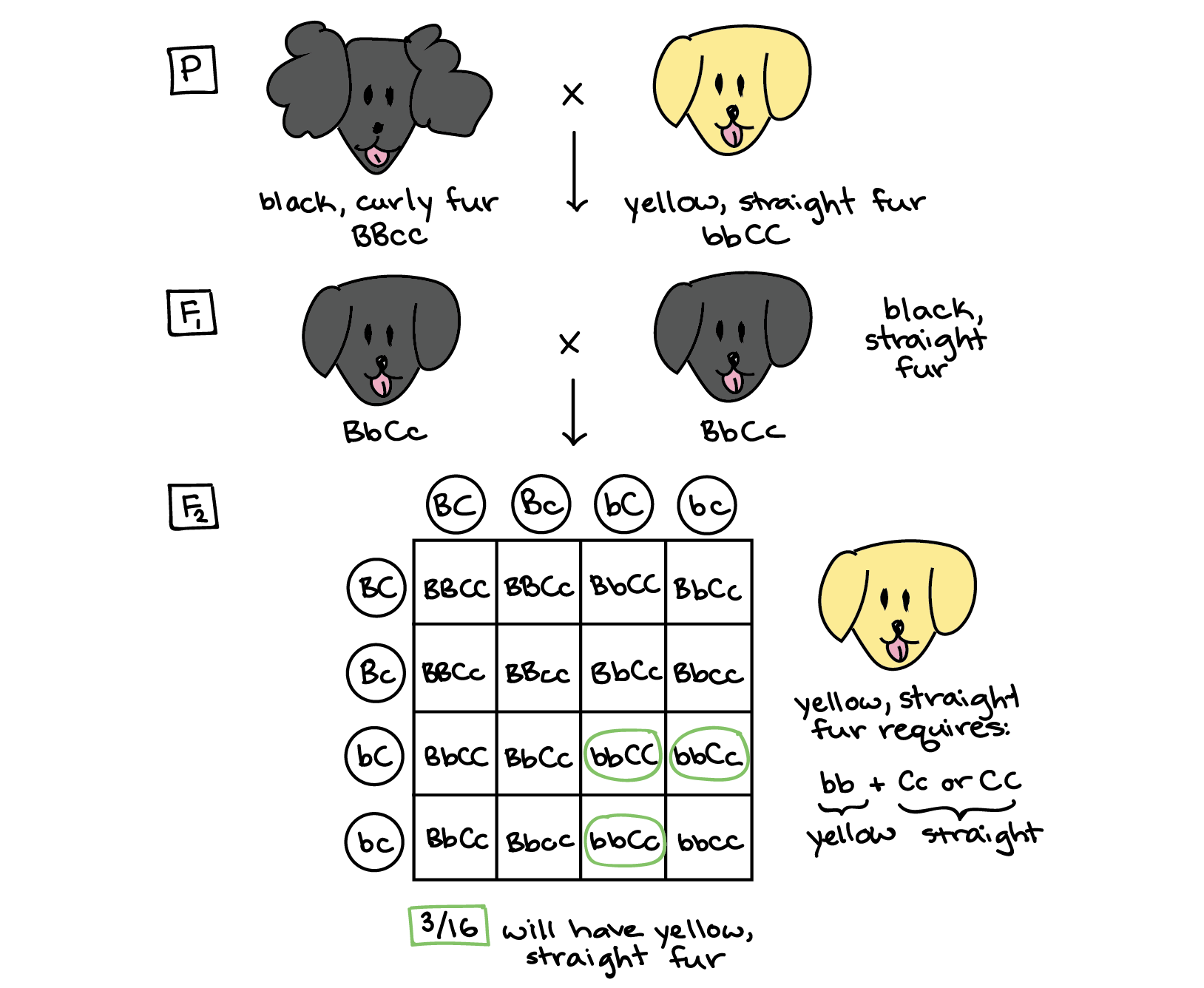
At present, nosotros need to find the squares that correspond to the outcome we are interested in: a puppy with xanthous, straight fur. To have yellow, straight fur, the puppy must get 2 recessive alleles for fur color (bb genotype) and at least one dominant allele for fur texture (Cc or CC genotype). If we go through the table and circle the genotypes that match these requirements, nosotros'll find that 3 out of the sixteen boxes stand for to yellow, straight-furred puppies. Thus, nosotros would wait 3/xvi of the Ftwo puppies to have yellow, straight fur.
Reply: 3/16.
Contributors and Attributions
-
Khan Academy (CC Past-NC-SA 3.0; All Khan Academy content is available for gratuitous at www.khanacademy.org)
- [Attribution and references]
-
Attribution:
This article is a modified derivative of:
- "Laws of inheritance," by OpenStax College, Biology (CC Past 3.0). Download the original article for gratis at http://cnx.org/contents/185cbf87-c72e-48f5-b51e-f14f21b5eabd@nine.85.
- "Laws of inheritance," in Principles of Biology, by Robert Deport, David Rintoul, Bruce Snyder, Martha Smith-Caldas, Christopher Herren, and Eva Horne, OpenStax, (CC BY 4.0). Download the original article for gratis at http://cnx.org/contents/db89c8f8-a27c-4685-ad2a-19d11a2a7e2e@24.18.
The modified article is licensed nether a CC By-NC-SA 4.0 license.
Works cited:
- Reid, J. B., and Ross, J. J. (2011). Mendel'south genes: Towards a full molecular characterization. Genetics 189(1), 3-10. http://dx.doi.org/10.1534/genetics.111.132118. Retrieved from www.ncbi.nlm.nih.gov/pmc/manufactures/PMC3176118/.
References:
Dihybrid. (2015). In The gratis dictionary. Retrieved from http://www.thefreedictionary.com/dihybrid.
Kimball, J. Due west. (2014, Apr 21). Genetic linkage and genetic maps. In Kimball's biology pages. Retrieved from https://www.biology-pages.info/Fifty/Linkage.html
Purves, W. M., Sadava, D. E., Orians, Thou. H., and Heller, H.C. (2004). Genetics: Mendel and beyond. In Life: The scientific discipline of biology (7th ed., pp. 187-212). Sunderland, MA: Sinauer Assembly.
Raven, P. H., Johnson, One thousand. B., Mason, K. A., Losos, J. B., and Singer, Due south. R. (2014). Patterns of inheritance. In Biology (10th ed., AP ed., pp. 221-238). New York, NY: McGraw-Hill.
Reece, J. B., Urry, L. A., Cain, M. L., Wasserman, Due south. A., Minorsky, P. V., and Jackson, R. B. (2011). Mendel and the cistron idea. In Campbell Biology (10th ed., pp. 267-291). San Francisco, CA: Pearson.
Reid, J. B., and Ross, J. J. (2011). Mendel'due south genes: Towards a full molecular characterization. Genetics 189(i), 3-10. http://dx.doi.org/10.1534/genetics.111.132118. Retrieved from www.ncbi.nlm.nih.gov/pmc/articles/PMC3176118/.
The Adapa Project. (2014, Baronial 13). What are the laws of segregation and independent array and why are they so important? In BioBook. Retrieved from https://adapaproject.org/bbk_temp/tiki-index.php?page=Leaf%3A+What+are+the+laws+of+segregation+and+independent+assortment+and+why+are+they+so+important%3F.
Source: https://bio.libretexts.org/Bookshelves/Genetics/Classical_Genetics_%28Khan_Academy%29/01:_Introduction_to_heredity/1.06:_The_law_of_independent_assortment
0 Response to "What is the Law of Independent Assortment when it comes to genetics"
Post a Comment